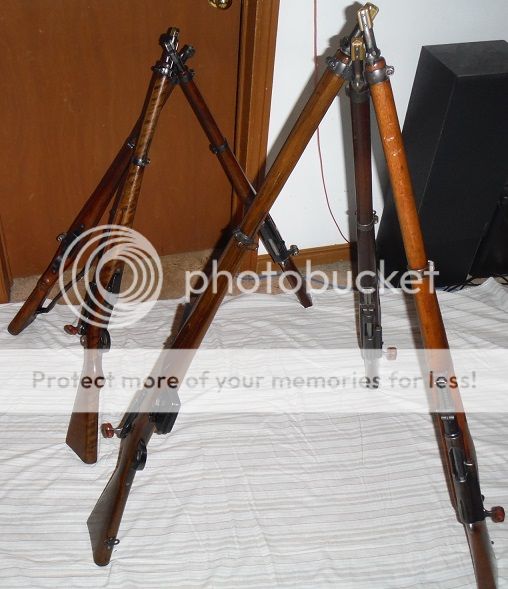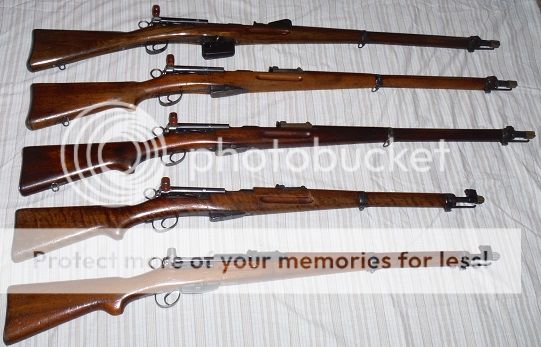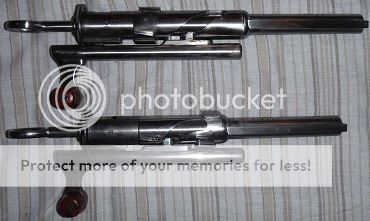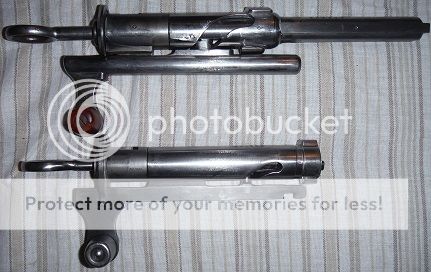Eaglelord17
CGN Ultra frequent flyer
- Location
- Sault Ste. Marie
Hi all,
Thought I would share with you all my Swiss collection as it stands at this point.

Here is a photo of some Swiss Rifles in Pile Arms. First group consists of a I.G. 1889, I.G. 96/11, and a I.G. 1911. Second group consists of two K31s and a K11.

From the top down, I.G. 1889 (made 1896), I.G. 96/11 (made 1904), I.G. 1911 (made 1915), K11 (made 1914 which is also first year of production for the K11), and K31 (made 1954).

This is a photo showing the difference between the 1889 and 1896 bolt designs (the 1896 was the last bolt design for the Schmidt Rubin series). Note the rear locking lugs on the 1889, and how much longer the bolt is. For ammo please note that it isn't safe to shoot GP-11 through a rifle with a 1889 style bolt. Fortunately there is really only one rifle you will encounter like that (the 1889).

The difference between the 1896 bolt and the K31 bolt. Note how much more compact the K31 bolt is (which allowed much more barrel than the K11 and a longer sight radius).
I intend to update this as I acquire more, however it might be a while as since I acquired the 1889, all the 'easy' to acquire firearms have been bought (next easiest rifle is a 1893 Carbine and there were only 8000 of those made).
Side note, the long rifles are called 'I.G.' or just 'G' which stands for Infantrie Gewehr (Infantry Rifle in German) or just Gewehr (Rifle). The 'K' stands for Karabiner (which means Carbine in German).
When you see dealers selling these firearms, sometimes they have the designation wrong calling all long rifles and carbines K1911s as they have no idea what the actual naming scheme is or how to tell them apart. It is not such a big deal when you buy in person as you can see the firearm, however when you order online be careful it is the model you are looking for (make sure to verify).
Thought I would share with you all my Swiss collection as it stands at this point.

Here is a photo of some Swiss Rifles in Pile Arms. First group consists of a I.G. 1889, I.G. 96/11, and a I.G. 1911. Second group consists of two K31s and a K11.

From the top down, I.G. 1889 (made 1896), I.G. 96/11 (made 1904), I.G. 1911 (made 1915), K11 (made 1914 which is also first year of production for the K11), and K31 (made 1954).

This is a photo showing the difference between the 1889 and 1896 bolt designs (the 1896 was the last bolt design for the Schmidt Rubin series). Note the rear locking lugs on the 1889, and how much longer the bolt is. For ammo please note that it isn't safe to shoot GP-11 through a rifle with a 1889 style bolt. Fortunately there is really only one rifle you will encounter like that (the 1889).

The difference between the 1896 bolt and the K31 bolt. Note how much more compact the K31 bolt is (which allowed much more barrel than the K11 and a longer sight radius).
I intend to update this as I acquire more, however it might be a while as since I acquired the 1889, all the 'easy' to acquire firearms have been bought (next easiest rifle is a 1893 Carbine and there were only 8000 of those made).
Side note, the long rifles are called 'I.G.' or just 'G' which stands for Infantrie Gewehr (Infantry Rifle in German) or just Gewehr (Rifle). The 'K' stands for Karabiner (which means Carbine in German).
When you see dealers selling these firearms, sometimes they have the designation wrong calling all long rifles and carbines K1911s as they have no idea what the actual naming scheme is or how to tell them apart. It is not such a big deal when you buy in person as you can see the firearm, however when you order online be careful it is the model you are looking for (make sure to verify).
Last edited:















































































